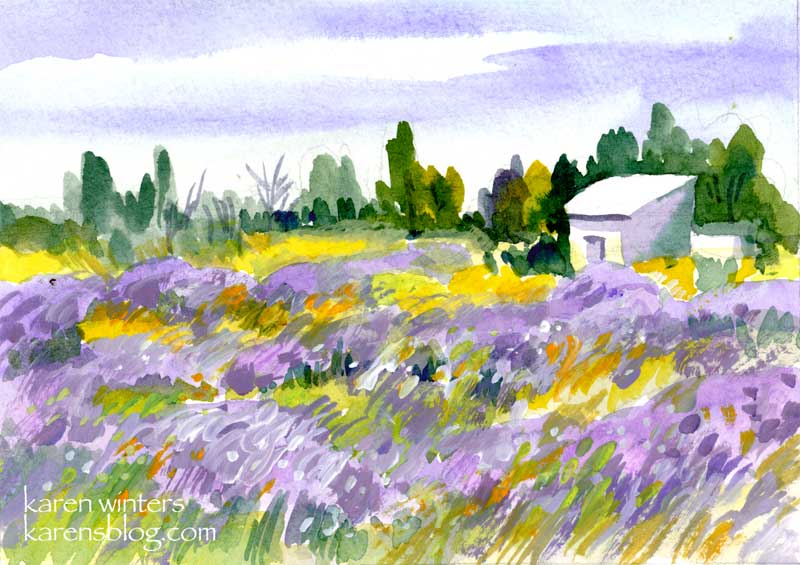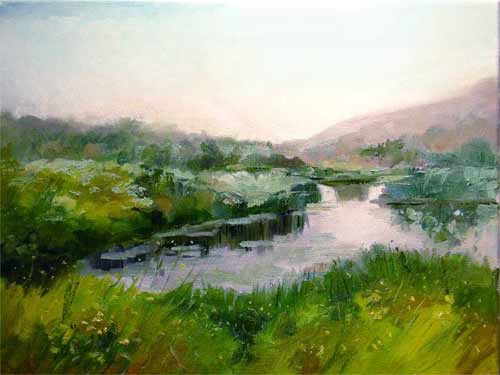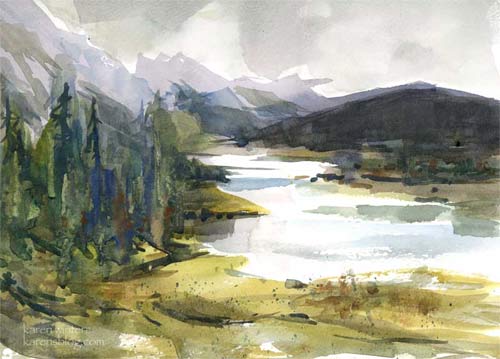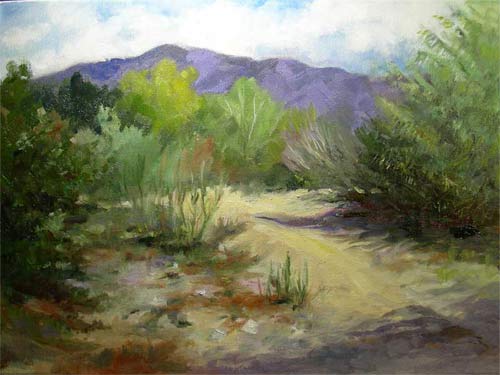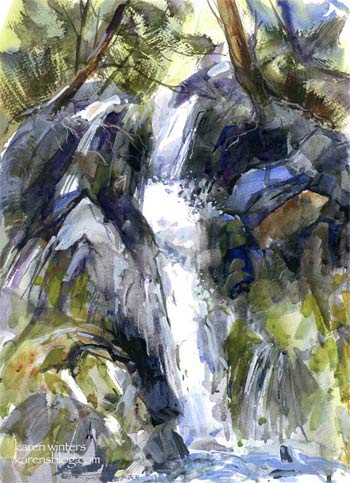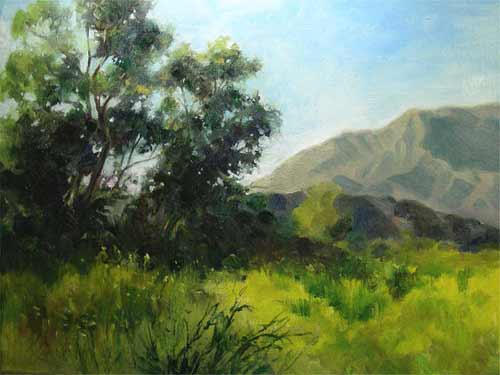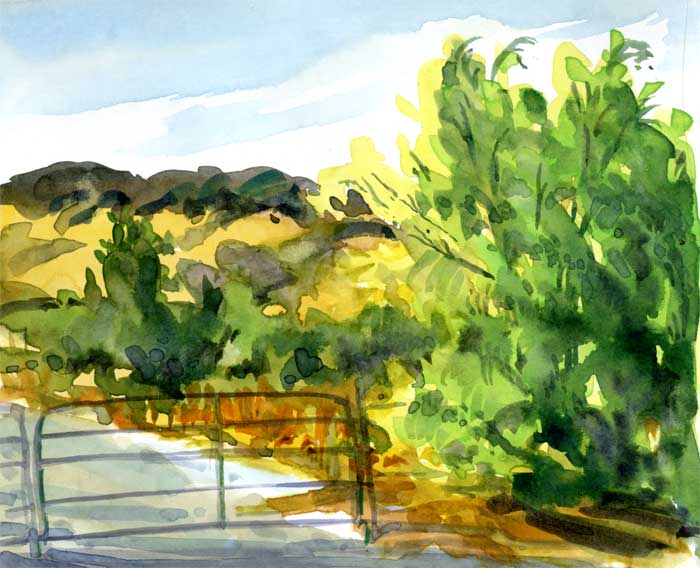At a Lavender Farm – Karen Winters Daily Painting
“At a Lavender Farm”
5 x 7 mixed media (watercolor and acrylic)
We have some friends who live in northern California who own a lavender farm. The climate is perfect for growing this beautiful fragrant plant. The plants actually grow in more regular rows than this, but I sort of like the wild blowsy look.
Sunday Sunshine – Karen Winters daily painting
Sunday Sunshine – 6″ x 6″ – watercolor with colored pencil accent
SOLD to a collector from Texas
Rather, this is the sunshine we WISH we had right about now. It’s been cold, wet and lightning is promised tonight. But I really can’t complain because this sort of weather is such a rare event and the gushing streams and wildflowers that follow will be glorious. In the meantime we’ll just snuggle up with an extra comforter and umbrella and wait until the sun breaks through.
This afternoon I painted this to remember the warmth of spring days yet to come. The lemon is from our tree and is presently full of new buds (if the rain doesn’t knock them off.)
Doing a painting like this is an entirely different experience from some of the bolder more expressive things I’ve posted recently. I’m not abandoning any style at the moment, I’m just exploring a range of techniques and looks. Painting something like this is a very quiet, meditative experience – using a smallish brush and taking quite a bit of time. Painting something like “Tumbling Down” for example, is an invigorating emotional experience, using a large brush and painting impulsively in a short period of time. They’re just … different experiences and sometimes one fits my mood more than another. You think maybe it has to do with caffeine? Hmmm … now there’s one to think about.
Edited to add: an art friend asked how I got the spotted effect in the lemon and how I did the edge of the lemon where the white of the paper is the bright spot.
The lemon was painted with multiple glazes of transparent watercolor – up to 5 layers, if I recall correctly. (Sometimes I forget when I’m in the flow of the moment.) The final glaze was a very pale orange and the uppermost spots were touched in with the tip of a small brush. The rougher spotty texture (toward the bottom of the lemon) comes from using a very light layer of colored pencil in the darks. The edge at the top of the lemon, where it meets the crystal, was just “painted around.” No masking was used.
Arroyo Pond – Arroyo Seco Painting – Karen Winters
Arroyo Pond – 12 x 16 oil on canvas
When the rains come, a part of the upper Arroyo Seco (in Hahmongna Park) can fill up with water, creating a seasonal pond. Here’s how it looked on one overcast day in early spring. I’m wondering what the current rainstorm will bring (this was from a few years ago.)
Conventional wisdom says that there should be a vertical element in a composition for balance when it is primarily horizontal, but in this case I think the purely horizontal format helps to reinforce the feeling of peace and tranquility. This view is from above Devils Gate – looking southward in the early morning in the direction of the Colorado Street Bridge. The hazy mist is typical when there’s a lot of moisture in the air.
Winter Reflections – Daily Painting
Winter Reflections – 10.8 x 7.8 inches – watercolor on paper
A subdued day – quiet colors under a grayed sky. Could a few drops of rain be ready to fall?
Early this morning, when there was a break in the storm, I went to Hahamongna Park to see how the Arroyo Seco river was flowing. There was certainly a volume of water, but nothing approaching dangerous. The stream was about a foot deep, I’d estimate, and about 15 feet wide at its widest. And there was snow in the mountains above. I would have liked to have painted but another storm started, so I just took photos instead.
Later today we spent some time at the Pasadena Museum of California art where a celebration is being planned to honor Milford Zornes, a celebrated watercolorist who is 100 years old – and still painting! Although Milford suffers from macular degeneration, he continues to produce remarkable works of art. We should all be so fortunate to have so many years to pursue our passion. They were hanging the Zornes show while we were there and what I saw of it looked spectacular. There were paintings from many private collections, from the 50s up to more recent times. His use of graduated washes is quite incredible and I look forward to seeing his works in more detail.
Arroyo Ramble – Pasadena Arroyo Seco
Arroyo Ramble 12 x 16 inches – oil
This is a part of the Arroyo Seco – a sandy river bottom that fills with water whenever there’s a big rain (like now.) One of these days soon I’m going to head over there and try to find some way to plein air paint while the waters are still flowing. I love it that we live in an area where wild nature is so close by (like 5 minutes away.) If you live in a rural area, that’s no big deal. But we live in a suburb of Los Angeles – so every bit of wilderness is treasured. Those are the San Gabriel mountains in the distance and they really are violet at certain times of the day. If the storm clears, maybe I’ll get over there tomorrow.
More later …
Tumbling Down – Karen Winters daily painting
“Tumbling Down” – 10 x 14 – mixed media on watercolor paper (wc and acrylic)
Last night, after I decided to stop working on an oil painting (for the moment), I took out a watercolor pad and thought I’d experiment with some of what I heard Jerry Stitt talking about – painting what things are “doing” rather than literally what they look like. This was the result.
I started with big bold washes with a wide hake (goat hair?) brush, and then started layering with other watercolor washes. I dropped thick paint into wet areas and let it run. I used the edge of a flat brush to sculpt some of the rocks. Dry brush was added here and there for foliage. Most of the white of the waterfall was the reserved white of the paper.
After the watercolor was dry, I went back in with acrylic (both diluted and full strength) to add more crevices to the rocks and to add to the spray effect over dark rocks. Knowing that I was going to include acrylic, I didn’t use any masking.
I only vaguely used a reference photo as a starting point and to understand the flow of the cascade. Most of the rocks were made up as the paint did its own thing and I needed to respond to it. That’s something else that I found fascinating from Stitt’s demo – he did his paintings completely out of his head based on his response to a very quick gestural drawing and what the paint was doing on the paper. Stitt has been painting for so many years that his knowledge of land forms is vast, so in a sense he’s relying on an internal reference library and a near photographic memory. But what he says is true. At a certain point in a particular painting you need to make the painting work and forget trying to match a scene “out there” in reality. I observed the same ability with watercolorist Barbara Nechis who invented landscapes as she painted … again building upon years of experience as a painter and observer of nature. This is yet another reason to keep a sketchbook and draw nature wherever you go. By this simple act you are committing nature to memory.
Spring Comes to the Arroyo – Karen Winters – Arroyo Seco daily painting
“Spring Comes to the Arroyo” – 12 x 16 oil on canvas
SOLD
Although this painting is sold, I’d be happy to paint something in a similar vein as a commissioned painting, in the size of your choice. Please write karen@karenwinters.com
Spring is first announced the the appearance of bright green grasses in the arroyo. These may emerge within weeks of the winter rain, covering the parched mountains and hillsides with brilliant chartreuse fuzz. Rosettes of mustard plants germinate and provide patches of darker green among the annual rye sprouts. Eventually the mustard grows tall , blossoms, and blankets acres of ground with yellow mist.
This past weekend I had the opportunity to see watercolorist Jerry Stitt demonstrate. He brings a great amount of energy and passion to his work, along with remarkable technique. One of the quotes that stayed with me was “I don’t paint what things ARE, I paint what they do.” He doesn’t want us to just see a boat, a lake, a hillside … he wants us to FEEL the sweep of the windblown tree, the flatness of the desert, the weight of the mountains. I learned a lot not only from what he painted by how he painted it as he put his whole self into his work with large gestures. Someone once said if he had a native American name it should be “Dances with Brushes” and that’s not far from the truth. He is also a trained ballroom dancer and that elegance and confidence comes through in the way he paints as well. A fascinating and talented painter. If you have a chance to see him demo (he lives in Sausalito) don’t miss it.
Breaking Through – Karen Winters Daily Painting
“Breaking Through” – 16 x 20 – oil on canvas – SOLD
This is the next in my series of marine paintings and it will go to the Descanso Gardens gallery in a day or so to replace the one that sold this past Monday. I’m really enjoying exploring this subject matter.
I’m thinking that this theme has been coming into my awareness for some time. I can remember scenes back into my teenage and young adult when I was absolutely rapturous at the sight of stormy skies and filtered light. Perhaps it moved me so much because clouds and storms are rare in Southern California and such events were fleeting and precious. Being on the beach at St. Augustine, Florida, as a storm moved in … seeing a thunderstorm in South Dakota while working on a Habitat for Humanity project … driving through New Mexico during monsoon season … these are images I will never forget. So these paintings are part of my journey of remembering – and I hope that they evoke memories for others as well.
A Life Drawing
Female portrait – for practice – charcoal on newsprint
One of my goals this year was to take a life drawing class – working from a live model. I’ve drawn from models on some other occasions but i was never close enough to get a good look at the head, and the models were nude which encouraged drawing the whole form, not just the head. They were also uninstructed events with short to medium length poses, not conducive to a slow study.
So this was the result from class 2, as far as we took it. We worked for about an hour or so because some of the time was spent in demo and lecture and some breaks. With more time I would have made this a more refined and corrected image, but when the model is done, time’s up. For scale, the top of the head to base of the neck is about 10.5 inches.
By far the hardest part for me was the seeing. My eyesight was poor as a child and hasn’t gotten better as I’ve grown up. And although I’ve tried many different kinds of glasses with a variety of magnifications, there’s always some compromise. I was about 8-10 feet from the model, I’d guess. If she had been sitting at arm’s length or 4-5 feet I think I could have done considerably better. The model was strongly lit from the top and to the right (camera right, not her right) which gave good shadows to work with and model form.
Eventually I think we’ll be drawing her unclothed and I may or may not post them, it depends upon whether or not that’s ok with her. She is a patient and friendly person and holds a pose remarkably well. She was very pleased to have a looking down position because it allowed her to read a book last night!
My objective with this, of course, is to work into oil portraiture. But as I’ve been reminded by the teacher, all practice drawing shape and value helps improve any kind of painting – including landscapes and still life. It’s additive and no practice is every wasted.
Peppertree Road – Karen Winters Daily Painting
Peppertree Road – watercolor sketch
Here’s another watercolor vignette from my sketchbook while I’m working on another large oil seascape. (To be posted as soon as it’s done.) My cold/flu bug is gone (at least enough) that I can contemplate painting in oils again, and so I am.
This little sketch was derived from color notes and photos I took on a trip to northern California. No matter what the season, peppertrees are evergreen here – always brightening the scene with their greens and yellows gleaming in the sun. I see them lining our highways and rural roads, gracefully nodding with every breeze. I love to paint them!
Here’s something I’d like you painters to think about: before you started painting did you look at trees and bushes, mountains and clouds in the same way that you do now? Do you find yourself drifting into a reverie when you see the sun coming out in a certain way and thinking … hmmm … is that sky blue cobalt or more toward cerulean? Do you paint with your eyes even when you’re away from your easel?
